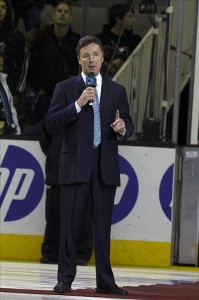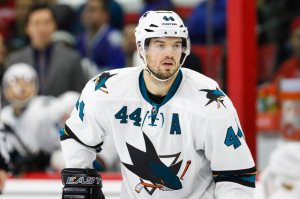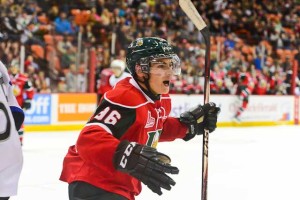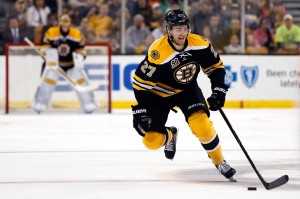I’ll admit it up front. I have no idea how any of the players drafted by the San Jose Sharks will pan out.
I’m a firm believer in the draft philosophy of ‘best player available’. There are those that think drafts should be based on a team’s positional needs. I don’t buy that. Others think it is critical to balance the draft between the major positions. I don’t buy that either.

Near-term needs get filled through trades and free agency. Draft picks, with few exceptions, generally take three to five years before becoming substantial contributors. How many of the current Shark players will still be on the team in three to five years? History can act as a guide. The Sharks roster that ended the season in the spring of 2011, just four years ago, had only seven players in common with the roster that ended this season in the spring of 2015. The Sharks roster that ended the season in the spring of 2011 had only six players in common with the roster that ended the season in the spring of 2007. Drafting for anticipated needs roughly four years down the road is a fool’s errand when 2/3 of the roster changes every four years.
As for balance among the various positions, that is likely to occur naturally, especially over several drafts. If a team winds up with excess quality in a specific area, trades can be made to address the imbalance. It is easier to make a trade if you have good players.
Determining Best Player Available
The ability to determine the best player available differs among organizations. Generally speaking, teams seem to have more success ranking forwards than defensemen. Goalies are probably the toughest to rank.
My colleague Andrew Bensch was among the analysts lamenting the early run on defensemen, with three going in the top eight picks, leaving the Sharks without a blueliner worthy of their draft spot at ninth overall.
History may offer some relief. In 2007, the top three defensemen selected in the draft were Thomas Hickey, Karl Alzner and Keaton Ellerby, all selected in the top 10. Later in the draft came Ryan McDonagh (selected 12th overall), Kevin Shattenkirk (14th) and PK Subban (43rd). In the 2006 draft, only Jeff Petry was worthy of his draft spot (45th overall) among the 14 defensemen selected in the first 50 picks. In the 2005 draft, the best defenseman selected was Marc-Edouard Vlasic, picked 35th.
In the last 10 years, five different players have won the Norris Trophy as the league’s best defenseman. None of these players were a top 10 pick and only Erik Karlsson, was a first round pick. You have to go all the way back to 2004, when Scott Niedermayer won the award, to find a Norris winner that was drafted inside the top 10. In that same time frame, seven different players have won the Hart Trophy as the league’s most valuable player. All seven players were first round picks, with six of the seven selected in the top five.

The lesson is pretty clear, determining the best player available is tough when it comes to defensemen.
Sharks general manager Doug Wilson has selected three defensemen in the first round during his 13 drafts: Ty Wishart, Nick Petrecki and Mirco Mueller. Two of the three have washed out of the league, while Mueller is too early in his career to say anything definitive, good or bad. A team should account for its drafting weaknesses, adjusting their perception of best player available accordingly.
Welcome Timo Meier

Watching the broadcast of the draft, I noted there was very little reaction from the broadcasters when Meier was selected; certainly no enthusiasm. These broadcasters had gushed over every prior selection. The cynic in me actually takes some comfort in that. Meier, along with pretty much every other draft pick, is largely an unknown. Projecting how an 18-year old will play five years down the road is, at best, highly error-prone.
In Wilson’s 13 years running the Sharks draft, he has taken four players between sixth and 10th overall: Meier, Devin Setoguchi, Milan Michalek and Logan Couture. Even top-ten picks are not locks for being top-tier players.
While Doug Wilson’s track record in Rd. 1 of the draft is mixed, he has gotten value after the first round. The best defenseman Wilson has drafted is the aforementioned Vlasic, selected in Rd. 2. The best forward is Joe Pavelski, selected in Rd. 7. Among the current Sharks selected by Wilson after Rd. 1 are Chris Tierney, Justin Braun and Tommy Wingels.
Wilson, like every other GM in the NHL, has to deal with basic draft reality: drafting is part skill, part crapshoot.
Opportunity Missed
One thing that a team can do in the course of a draft is to trade an unknown for a known. This approach can be wise if the right player becomes available. There are times an organization needs to take a risk on upside, other times they need to mitigate the downside. For the Sharks, it was essential that the ninth overall pick not be a miss. Mitigating the downside risk made a lot of sense, if the opportunity presented itself.
In that regard, the Sharks appear to have missed a major opportunity.

The Boston Bruins traded their young defenseman, Dougie Hamilton, to Calgary for three draft picks. The highest pick in the trade was the 15th overall pick. A pair of mid-second round picks were also in the deal. Hamilton is a move the needle player, good enough to make a team better.
Hamilton would have been an ideal fit for the Sharks. The Sharks need a top-pairing, quality right-handed defenseman. Hamilton is exactly that. The issue with Hamilton and the Bruins was cap space. The Sharks don’t struggle in this area. The Sharks, with the ninth overall pick, had more value to offer the Bruins than Calgary. Further, the Sharks organization, including owner Hasso Plattner, stated their intent to go after good players on teams that were being squeezed by the cap. That description fit the Bruins perfectly. That is what the Sharks said they were looking for. On this one, they missed.
The Results Are … Not In
Meier could, at some point, become a more valuable player than Hamilton. Or he could be less valuable. Time will tell the story. Hamilton is a known quantity; Meier is unknown.
Trading for Hamilton would have insured the Sharks the equivalent of a solid selection. It would also have addressed a position where their need is great. This sort of risk averse move is in Doug Wilson’s comfort zone. Wilson has been risk averse when it comes to signing players to large and lengthy contracts. He wants to avoid the downside risk of a major deal going bad. Trading for Hamilton would have avoided the downside risk of a high pick going bad.
This story might have other twists to it. There may be issues behind the scenes about Hamilton, which made him unappealing to Wilson (of note, the Sharks had Hamilton’s brother, Freddie, in their organization after drafting him in 2010; Freddie was traded earlier this year). Wilson might consider an offer sheet for Hamilton, who is a restricted free agent, as an alternate way to get him, potentially at a perceived lower cost than via a direct trade.
A key part of being an effective general manager is making the risk/reward balance work in your favor. Trading for Hamilton might not have been as exciting as having a prospect like Meier enter the organization, but it seems like the smarter play.
A few years from now, we will start to have an idea if this draft was a good one or not for the Sharks. We can also decide if the trade that did not happen — the pick that became Meier for Hamilton – would have been a good one. As of today, it looks like a missed opportunity.